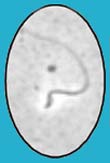Sniff and Swim: How Sperm Find Eggs

Mice are especially good at sniffing out cheese in a maze, and a new study reveals their sperm are just as good at tracking an egg cell's scent.
Even when ovary extracts were extremely diluted, sperm still flocked toward an unknown smell, according to a study in this week's issue of the journal Analytical Chemistry. [Video]
Understanding how sperm are attracted to ovaries and eggs might lead to treatments for problems with human conception.
Sperm on a treadmill
Although scientists are still trying to figure out the exact chemicals that urge such an attraction, sperm swim vigorously in the direction of extracts from various female reproductive organs, especially ovaries.
Scientists call this type of attraction chemotaxis.
To see just how strong the attraction is for mouse sperm cells, researchers at the University of Indiana, Bloomington forced sperm to swim on a sort of liquid treadmill. It worked like this: Liquid entered from three channels on the right that joined up to flow leftward in a larger tube.
Sign up for the Live Science daily newsletter now
Get the world’s most fascinating discoveries delivered straight to your inbox.
Off you go!
The sperm cells entered through the middle channel, ovary extract through the bottom, and a control buffer solution through the top. This gave the sperm cells two options as they're carried through the main channel—go for the buffer or go for the ovary.
As seen in this time-lapse image and in a video, the sperm enthusiastically swim toward the ovary extract at the bottom of the channel. Even when the extract was diluted 100,000 times, some sperm still swam toward it.
"Defects in sperm chemotaxis may be a cause of infertility, and consequently, sperm chemotaxis could potentially be used as a diagnostic tool to determine sperm quality or as a therapeutic procedure in male infertility," said study co-author Stephen Jacobson.









